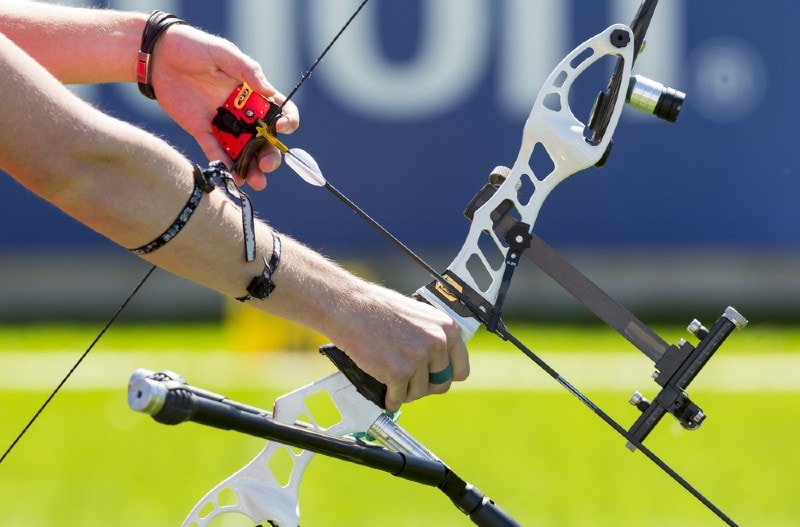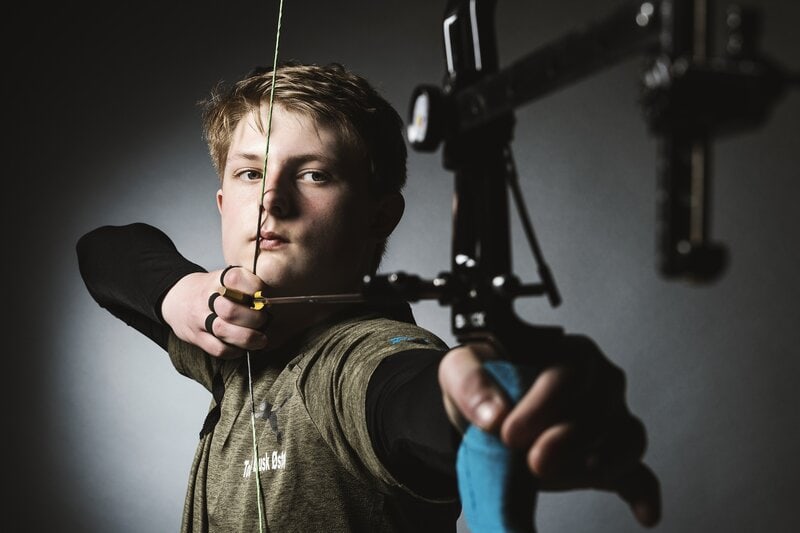Can You Hunt With a Recurve Bow? Regulations, Safety, & FAQ
Last Updated on

Since the medieval period, recurve bows have been popular in bowhunting and recreational shooting. Archers prefer them because they require less energy and deliver powerful shots.
Recurve bows are super easy to carry and make less noise than other hunting weapons. They are even used in Olympic archery competitions due to their high accuracy. But unfortunately, many hunters struggle to find a recurve bow with the right draw weight.
If you’re a beginner, you may have difficulty using recurve bows and finding a suitable draw weight. This guide will tell you everything about hunting with a recurve bow, its advantages, effective range, and state regulations.

Are Recurve Bows Good for Hunting?
Recurve bows are excellent for hunting but require experience and skills for shooting accurately. They are similar to longbows—the only difference is that the limbs of a recurve bow are curved back from the end and stock up energy when you draw the bowstring.
These bows also allow archers and hunters to shoot with extra power. Here are some benefits of using recurve bows for hunting:

Silent
No hunter wants to keep chasing an animal for hours or lose it after putting in a lot of effort. If your hunting weapon makes noise, your prey will likely run away in a blink of an eye. Even a bit of noise from the bows can scare animals off.
A recurve bow is well known for making less noise, but don’t expect it to be completely silent. Most recurve bows come with unique limbs and dampers made of quiet components. They are attached to the strings, so the bow creates negligible noise whenever you take a shot. This makes a recurve bow an ideal choice for hunting.
Improved Draw Weight
Every hunter wants to take a shot that kills the target animal quickly instead of piercing through it and injuring it. The draw weight plays a significant role in killing an animal without hurting it.
Of course, not all recurve bows have a better draw weight. So, you must search through the market and find the one that has. The ideal draw weight in a recurve bow is at least 40 pounds.
Good Length
A recurve bow is not only used in hunting but for archery competitions as well. So, it may not be the best hunting weapon, but it offers an extraordinary length to target animals in the wild.
When buying a recurve bow, go for one with a minimum length of 58 inches. It is the ideal length for shooting and taking down targets.

What Is the Range of a Recurve Bow?
Recurve bows can cover an area of hundreds of yards from the point of the shoot. The accurate shooting rate of a recurve bow typically ranges from 60–100 yards, but the ideal distance is between 20–40 yards.
Remember that the range of a recurve bow varies depending on the arrow weight, draw length, and draw weight.

Recurve Bow Hunting Regulations in the US
The regulations for recurve bow hunting in the US vary from state to state. Here are some of them:
Alaska, Arkansas, Connecticut, Illinois, and Idaho
Within these states, you can use a recurve bow for hunting. However, you must follow the minimum 40-pound draw weight requirement when hunting larger game animals, such as wolves, black bears, deer, etc.
In Connecticut and Illinois, you can’t use mechanical strings. Illinois also has a minimum 20-inch arrow length requirement. In Arkansas, you must use specific arrowheads (⅞ inches wide) and mechanical broadheads for deer, bear, and turkey hunting.
Idaho has a restriction of 24 inches of the broadhead. The use of poison on the arrows is strictly prohibited in all these states.
Delaware, Florida, Indiana, and Hawaii
Within the states of Delaware and Hawaii, you can use the recurve bow with a minimum of 35 pounds of draw weight for hunting.
Nebraska
In Nebraska, you can hunt with a recurve bow having a minimum of 125 pounds of draw weight.
Montana
You can use recurve bows in Montana with a minimum length of 28 inches. There is no minimum draw weight.
Nevada
You can only use those recurve bows in Nevada that can throw the arrow at a minimum of 150 yards. In addition, the arrows must be 24 inches long with a broadhead of at least 7 inches.
Maryland and Minnesota
Within these states, you can use the recurve bow with a minimum of 30 pounds of draw weight.
In many states, including California, Louisiana, Arizona, Mississippi, Michigan, Kentucky, Missouri, Kansas, Alabama, and Georgia, you can hunt all animals with no size and length restrictions for arrows and broadheads. Check the recurve bow regulations in your state before hunting.

How to Use a Recurve Bow for Hunting
If you’re an amateur, you should mark the target area so everyone can see clearly from a distance. Then, follow these steps to use a recurve bow most safely and accurately:
- First, assemble the recurve bow and hold it firmly. The ideal grip is when your fingers are nearly touching the thumb.
- Then, make the standard archery posture and prepare yourself. Remember that your posture is the foundation of your shot accuracy, so ensure it’s correct.
- Knock the arrow while ensuring that the arrow fetch is towards the archer. The arrow should have a straight path from the bow to the target.
- Ensure you’re wearing the finger tab for safety, especially if you’re a beginner. Then use one finger to pull the string from the top and two more fingers to pull it from the bowstring’s bottom.
- Next, point the arrow in a flat path to the target and gradually draw the string toward your face.
- It’s easier to follow the Olympic style when drawing the string. According to it, your fingers must touch your jaw, and the string should run up your nose tip, chin, and lips.
- Lastly, take deep breaths, relax, focus on the target, and shoot.
Safety Rules When Using Recurve Bow
If you’re a beginner, you must learn the safety rules to prevent injuring yourself and the target animal.
- Inspect the bow. Before hunting, carefully inspect your bow. Focus on the recurve bow’s string, limbs, and riser and ensure it’s not damaged.
- Never dry fire. It’s better never to dry fire the bow (shooting without ammunition), as it can cause damage to you, someone around you, and the recurve bow.
- Avoid arrows weighing less than 200 grams. It’s recommended to never shoot the arrows with less than 200 grams weight as they can damage your bow.
- Prevent heat and moisture exposure. Don’t expose the bow to moisture and heat for extended periods, as it may damage your bow unexpectedly.
To avoid any injury, you should get help from a professional archer to learn the essential tips and tricks.
Drawbacks of Using a Recurve Bow
When using the recurve bow, you may encounter a few downsides that longbows or compound bows don’t have.
- It’s Old-Fashioned: It’s tricky for a beginner to learn to use a recurve bow and take accurate shots. That’s primarily because these bows are old-fashioned and require extensive skills and experience in shooting arrows compared to modern bows.
- Animal Injuries: Whether you’re an experienced hunter or an amateur, there is always a higher risk that your shot may injure the animal instead of killing it. That’s because many hunters usually ignore checking the draw weight, arrow length, and draw length of the recurve bow. These factors ensure that the arrow penetrates the animal’s body completely.

Final Thoughts
Recurve bows can be an excellent addition to your hunting weapons collection. These traditional bows look almost similar to the classic longbows and compound bows. However, they have curved limbs and require less energy to deliver powerful shots.
If you’re a beginner, you must know the correct recurve bow posture and safety tips to prevent injuries. Then, keep practicing with your recurve bow to learn to take accurate shots every time you pull the string.
Don’t forget to check the hunting regulations for recurve bow’s draw weight and arrow’s length in your state.
Featured Image Credit: Belish, Shutterstock
About the Author Jeff Weishaupt
Jeff is a tech professional by day, writer, and amateur photographer by night. He's had the privilege of leading software teams for startups to the Fortune 100 over the past two decades. He currently works in the data privacy space. Jeff's amateur photography interests started in 2008 when he got his first DSLR camera, the Canon Rebel. Since then, he's taken tens of thousands of photos. His favorite handheld camera these days is his Google Pixel 6 XL. He loves taking photos of nature and his kids. In 2016, he bought his first drone, the Mavic Pro. Taking photos from the air is an amazing perspective, and he loves to take his drone while traveling.
Related Articles:
Can You Use Binoculars to Look At Stars? How to Choose the Right Pair
How to Clean a Refractor Telescope: Step-by-Step Guide
How to Clean a Telescope Eyepiece: Step-by-Step Guide
How to Clean a Rifle Scope: 8 Expert Tips
Monocular vs Telescope: Differences Explained (With Pictures)
What Is a Monocular Used For? 8 Common Functions
How to Clean a Telescope Mirror: 8 Expert Tips
Brightfield vs Phase Contrast Microscopy: The Differences Explained
